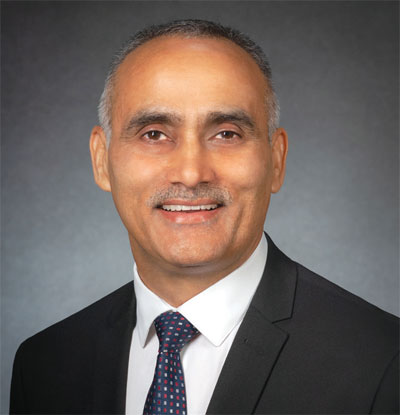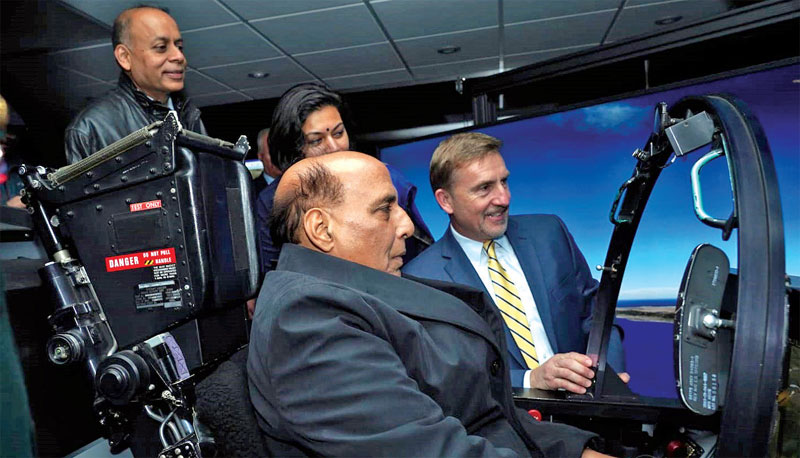Boeing will adopt a ‘‘By India-For India’’ sustainment approach, training services & upgrades, leveraging our current supplier base in India for the Super Hornets
 What are the timelines of additional P-8Is for the Indian Navy?
What are the timelines of additional P-8Is for the Indian Navy?
The P-8I has demonstrated an excellent record in supporting the missions it has been deployed for, and the Indian Navy has expressed satisfaction about their operational readiness. The contract for four additional aircraft was signed in July 2016. Based on the contract, the first of the four aircraft would be delivered in mid-2020.
Boeing takes pride in its worldwide programme for product support and maintenance. How are you integrating new technologies and AI in ensuring a higher rate of availability of your products?
Big data is changing the world of aerospace. Our team of analytics experts transforms data into actionable insights and innovative solutions to ensure the predictability of a no-surprises operation today. This team of professionals, including software engineers, system engineers and data scientists help create analytics tools for our customers to make critical and informed decisions. Boeing utilises methods such as machine learning, simulation and modelling, advanced forecasting and predictions, artificial intelligence, statistics, network analysis and pattern recognition. We provide end-to-end data analytics solution for the entire sustainment process, i.e., mission planning, MRO management, supply chain logistics. Our customers use Boeing solutions to optimize missions, increase operational efficiency and reduce costs.
How is the programme for IAF’s Chinooks and Apaches coming along? What are the timelines for completion of the programme? Any update on the Indian Army’s programme for Apache helicopters?
Boeing has been a strong partner in the mission readiness and modernisation of the country’s defence forces. Our advanced, proven portfolio of products and services offer unmatched operational capability across the entire mission spectrum for the armed forces. This partnership has been growing incrementally every year with the deliveries of the C-17 Globemasters, the AH-64E Apaches and the CH-47(I) Chinooks to the Indian Air Force (IAF), and the P-8Is to the Indian Navy.
Today, India has 10 CH-47(I) Chinooks against an order of 15 and 17 AH-64E Apaches against an order of 22. Both the Chinooks and the Apaches were inducted by the IAF in 2019. Boeing also delivered the 11th C-17 to the IAF in 2019. The remaining aircraft are expected to be delivered as per schedule.
The Indian Army is looking at acquiring six Boeing AH-64E Apache helicopters as part of a follow-on options order to the earlier IAF acquisition.
With reference to Make in India, what is your level of engagement with the Indian industry? What kind of eco-system have you created and to what extent is it part of your global supply chain?
It is a matter of great pride for us to partner in the country’s “Make in India” initiative. Boeing has been steadily increasing its sourcing from India for its global manufacturing and supply chain.
Today, we have more than 200 suppliers providing advanced, complex components and subassemblies for our commercial and defense aircraft as part of an integrated global supply chain. These parts and assemblies cover critical components such as aero structures, wire-harness, composites, forgings, avionics, mission systems and ground support equipment for Boeing’s commercial and defense aircraft.
For instance, Tata Boeing Aerospace Limited in Hyderabad, Boeing’s joint venture with Tata Advanced Systems Limited, is already manufacturing AH-64 Apache fuselages for customers around the globe.
Dynamatic Technologies manufactures the ramp and complex aft pylon for the Chinook heavy-lift helicopters. Similarly, Rossell Techsys manufactures wire harness and electrical panel for the AH-64 Apache, and the harness for V-22 Osprey. SASMOS HET Technologies manufactures electrical panel assemblies and wire harness for the F/A-18 Super Hornet and F-15 Strike Eagle. Hindustan Aeronautics Ltd. (HAL) manufactures F/A-18 gun bay doors and wire harnesses, and P-8I weapons bay doors and identification friend-or-foe transponders.
We are constantly looking at doing more here, given the proven ability of our partners to deliver world-class quality, talent while maintaining cost-efficiency and productivity.
The Indian defence minister was recently briefed on F/A-18 Super Hornet during his visit to the US. What were the highlights of the briefing? What were the areas of his interest?
Rajnath Singh was offered a virtual flying experience with the F/A-18 Block III Super Hornet simulator to understand a wide range of missions, carrier-based aviation and capabilities the aircraft can offer the Indian Navy. He was briefed about the advanced capabilities of the F/A-18 Super Hornet by the US Navy and he witnessed a flypast of the Super Hornets.

The naval fighter programme is likely to start soon with the RFI already in public domain. How do you view this programme? How effective is the argument of ‘commonality of platforms’? Why do you think it will be a good fit for the Indian Navy?
The Indian Navy and Indian Air Force have a clearly stated need for medium multi-role fighters and we’re working with them through their procurement process. We responded to the Indian Navy’s RFI for 57 aircraft and the Indian Air Force’s RFI for 110 aircraft, and have been briefing them about our differentiators. Multiple conversations have also taken place between the two governments on the F/A-18.
The opportunities for collaboration between the two navies on the naval aviation ecosystem, carrier integration, training and technology are very compelling, and the F/A-18 is a lynchpin of that cooperation. We are confident that our offer for India provides the best capability with the Block III, unrivalled growth potential, superior economics in platform and lifecycle costs, and a commitment to partner with India to build its aerospace ecosystem with our supply chain, engineering workforce and innovation and technology initiatives.
The Block III Super Hornet is uniquely suited for the Indian Navy’s operational environment. Built to meet the broadest range of mission needs, the Block III delivers the world’s most contemporary war-fighter technologies for unique and differentiated capabilities while offering full compatibility with India’s naval carriers without modifications.
The Block III Super Hornet’s multi-mission capabilities include battle-space situational awareness, counter-stealth targeting, greater range, increased acceleration and improved survivability that the Indian Air Force and Indian Navy can benefit from. The fighter can carry variety of munitions for multi-role engagements. The Super Hornet has advanced network architecture in the form of a new computer that works with high throughput data link offers advanced network-centric warfare capability. A new 10 X 19 inch touchscreen display provides the pilot with the capability to see, track and target multiple targets generated by the common tactical picture.
Beyond its advanced technology, the Super Hornet was designed as a carrier-based fighter for high-loading, high-stress operations with minimal support equipment required. These operational requirements have allowed for nearly two decades of naval operations in all-weather conditions and long duration deployments flying all types of mission profiles. The Block III Super Hornet is compatible with STOBAR and CATOBAR take-offs.
Today, the Indian Navy has eight P-8I long range maritime reconnaissance aircraft and more are expected to be delivered. The F/A-18 Super Hornets can optimally interface with the P-8I and other US platforms soon to be inducted in the Indian Navy. This is sure to augment the lethality of these platforms, enhancing India’s force projection capabilities.
Further, with both one-seat and two-seat variants, Super Hornet align directly with the Indian Navy’s training philosophy and mission. Both configurations are capable of performing all missions from a carrier. Additionally, the two-seat ‘F’ model can provide training capabilities which matches the Indian Navy’s concept of operations (conops) for carrier qualifications of fighter pilots. The ‘F’ model also allows for flying complex or heavy-integration missions that would benefit from the additional aircrew.
Beyond manufacturing, F/A-18 Super Hornet would provide attractive economics to IAF and Indian Navy for operations and upgrades. The large fleet size that will be in operation till 2050 and beyond offers most economical way to get access to new technologies. Boeing will adopt a ‘By India – For India’ sustainment approach, training services and upgrades, leveraging our current supplier base in India for the Super Hornets. This will offer high rates of mission readiness at competitive pricing throughout the lifecycle of the fighter.
Boeing has been engaged in capacity-building at the educational institutions’ level. Can you please elaborate on all the programmes that you have been undertaking in this area?
Boeing invests in externship programmes in top engineering colleges where students are exposed to advanced engineering projects and best practices. We have partnered with Nettur Technical Training Foundation (NTTF) to provide vocational training to qualified students and with Air India Engineering Services Ltd and the ministry of civil aviation to provide an Accelerated Apprenticeship Programme for aircraft maintenance engineers (AME) that is in its second year currently.
Additionally, in order to meet the demand for advanced skill sets, our Indian partners Rossell Techsys, TAML, Jaivel and Lakshmi Machine Works are imparting Boeing-designed curricula and initiatives. Most students find employment with our supplier partners on graduation when they get an accredited post-diploma.
Over the years, Boeing through its programmes such as the annual Boeing-IIT National Aeromodeling Competition, HorizonX India Innovation Challenge and the Boeing University Innovation Leadership Development (BUILD), has made a significant impact in empowering entrepreneurs, and promoting aerospace innovation in India. India is one of the top entrepreneurial ecosystems in the world, and we believe in India’s potential to define the future of aerospace across the globe.

